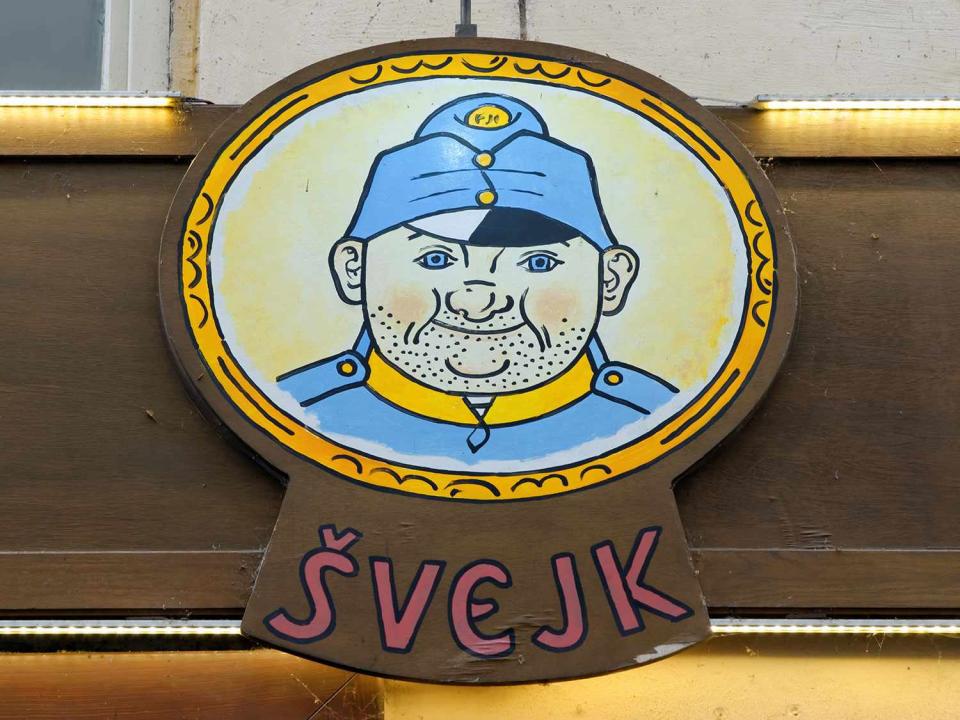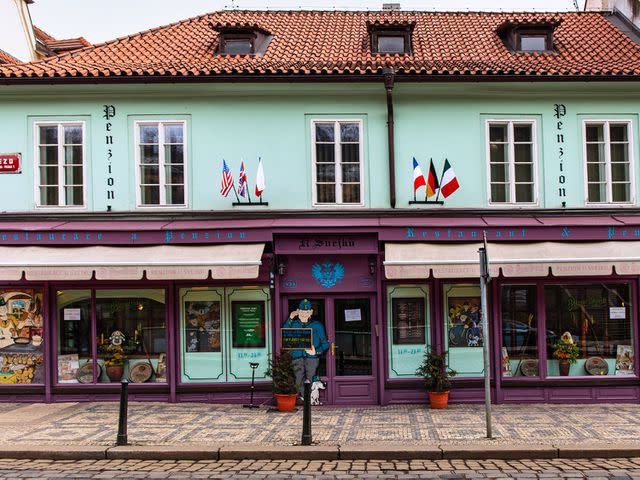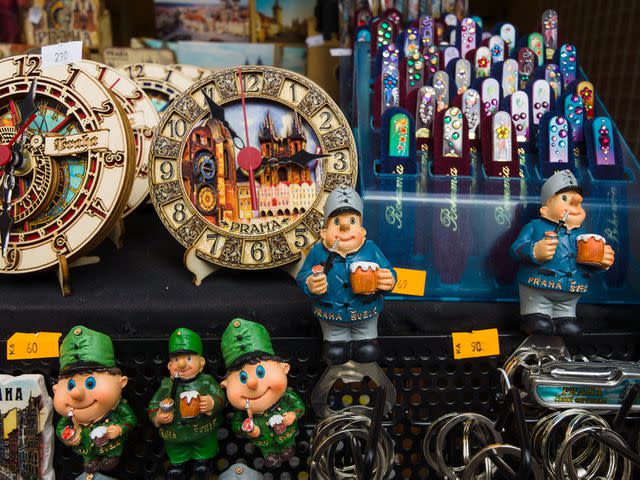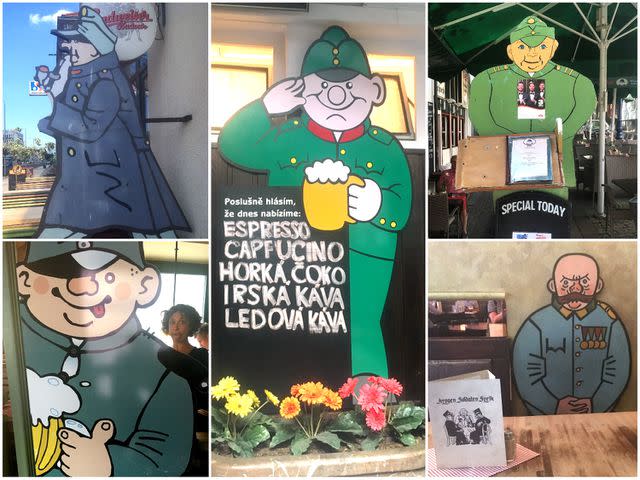How a 1920s Novel Started an International Restaurant Craze
Why has Jaroslav Hašek's 1923 novel 'The Good Soldier Švejk' served as the inspiration for many restaurants across Europe?

Jaroslav Hašek’s The Good Soldier Švejk is the funniest unfinished satirical war novel that has ever spawned an international restaurant craze.
Written in the 1920s and set during World War I, the book begins right after the assassination of Franz Ferdinand, a time when Czech lands were part of the Austro-Hungarian Empire and Czechs were drafted, often against their will, into the imperial army. All of its characters are trying to avoid military service—all, that is, save the hero Švejk (pronounced “Shvake,” to rhyme with Shake 'n Bake), who’s dying to enlist. With his sweet smile, boundless enthusiasm, and innocent, childlike face, Švejk is certified by a military medical commission as an “official idiot,” and his actions frequently disarm his commanding officers. But the reader never finds out whether Švejk’s idiocy is genuine or an act he puts on to get away with outrageous behavior. On a literary family tree, the book is grandfather to both Catch-22 and Amelia Bedelia.
One of its most iconic scenes illustrates the tensions of the era, and the ambiguity of the hero’s intentions: Švejk is arrested for treason at his favorite bar, U Kalicha (At the Chalice), after he says, “Get drunk, have the Austrian national anthem played, and you’ll see what you start saying!” The tight-lipped, mustachioed bar-owner Palivec is also arrested for the ignominious crime of letting flies land on and defile a portrait of the emperor.
Nearly 100 years after the book’s publication, Švejk remains firmly entrenched in the cultural imagination of not only the Czech Republic but the surrounding region. I’ve been working on a dissertation about The Good Soldier Švejk for the last few years, and while it’s still the subject of scholarly debate and is taught in classrooms the world over, the most visible evidence of its influence is in the restaurant industry: Hašek’s novel has inspired restaurateurs across Europe, from Scandinavia to the Balkans, to open Švejk-themed restaurants. If you’ve ever vacationed in Prague, Athens, or Copenhagen, you may have seen Švejk smiling down on you over dinner; you might’ve stopped in for a beer at a place called U Švejka—Czech for "chez Švejk"—or even occupied a table in the real-life U Kalicha.
Which is funny, because there isn't actually a whole lot of food in the book—or, to be precise, there isn’t much eating. Instead, the reader is treated to long scenes of soldiers fantasizing about the food they miss from back home: roast pork with beets, horseradish and mustard, stewed goose with red and white cabbage and pork-fat dumplings, homemade cracklins. The meager rations they’re promised never materialize, and they travel hundreds of miles by train without ever being fed.

Of course, Švejk isn’t the only book to inspire restaurants; there are British pubs called "Oliver Twist,” and there are Don Quixote–inspired tapas restaurants. But the ubiquity of the Švejk restaurant is curious, especially because it’s a pretty dark novel, not to mention a difficult modernist text. How many eating establishments have found inspiration from books that feature sadistic doctors administering daily enemas to recalcitrant recruits? A restaurant that pays homage to Švejk isn’t that far off from a restaurant modeled on a story by Hašek’s contemporary Franz Kafka—a place everyone says you have to go to, but you can’t find the address on a map, the hours aren’t posted anywhere, and the menu is just a list of everything you’ve ever done wrong in your life, read aloud by your father.
So why Švejk? Who opens these joints, and who eats there? What’s on the menu, and what’s on the walls?
Last summer, I decided to put down my library card and pick up my passport. I planned a route that would take me by train to all the Švejk restaurants I could find on the continent, eight countries in all, to uncover the origin and development of this phenomenon. I was able to conduct interviews in Czech, Russian, and German; in countries where other languages are spoken, I put out a call to local friends and friends of friends for interpreting services. Turns out, people are amazingly helpful when compensated in dumplings.
* *
The oldest Švejk restaurants are actually just really old Czech restaurants, places Hašek used to go during his lifetime. He was a heavy drinker, so a lot of real Prague bars are mentioned in Švejk, some of which redecorated following Hašek’s death and rose to international fame in order to capitalize on the connection. These restaurants—including the real-life U Kalicha, which other Hašek scholars (in Czech we’re called Haškolog, or “Hašekologists”) told me was probably the original Švejk restaurant—feature decor inspired by the novel, often reproducing the iconic illustrations by Josef Lada, cartoonish drawings in which Švejk is chubby-cheeked and cherubic. (The rights to the illustrations are the property of Švejk Restaurant, the largest franchise in the Czech Republic; other restaurateurs use them beyond the limits of the law.) You’ll also see vintage Švejk tchotchkes like beer steins and figurines, Habsburg kitsch like portraits of the last emperor, and World War I paraphernalia, because apparently nothing whets the appetite like a 100-year-old gas mask.
The clientele at these joints is a mixed bag. Some are tourists looking for something “authentically Czech,” but many, of course, are fans of the novel, which has become such a classic of world literature that it’s been translated into more than 60 languages. For example, the day I visited U Kalicha, I met Estonian tourists who were delighted to step into the world of their favorite book. For them, a trip to U Kalicha was nothing short of a pilgrimage. But because the book has also been adapted into plays, films, and comics, the image of Švejk is instantly recognizable even to many people who haven’t read the book.
To the Czechs, Švejk represents a particular brand of playful, even absurd resistance—he’s subversive, but never gets in too much trouble because, after all, it’s not illegal to be an idiot. To the rest of the world, though, Švejk represents the Czechs.

And so, at the international Švejk restaurants, items from the Czech Republic specifically seemed to be highly prized, spoken of almost as if they were holy relics, like the rosary beads your Catholic grandmother bought in Vatican City. A lot of the food at these restaurants is typical Czech cuisine, meat-heavy and hearty, along the lines of what the soldiers in Hašek’s novel longed for—classic dishes like goulash with bread dumplings, pork ribs, roast duck, and schnitzel, best accompanied by lager.
These international Švejk restaurants can be divided into two categories—ones that opened during the communist era, which are mainly owned by Czech emigrés, and ones that have opened since the fall of the Iron Curtain. As Soviet Bloc countries transitioned to democracy, Švejk was sometimes used to express nostalgia for a romanticized, pre-communist past, which is pretty ironic, considering that in the novel, Švejk is rebelling against the imperial order of which he’s now supposed to be a symbol.
* *
Spiros Koulouris is of Greek descent, but grew up in Prague and emigrated back to Athens during the communist period. When he opened the first Czech restaurant in Greece, back in 1982, he named it U Švejka, after his favorite novel. The restaurant, chock-full of memorabilia and opening into a lush patio, feels like a perfect blend of a Czech beer hall and a Greek taverna. Koulouris and his wife Aphrodite are marvelous hosts, but it felt unnatural to be eating heavy Czech food on a hot July day in Athens. (A lot of Švejk restaurateurs told me their food sales go down in the summer months, pushing them to rely on beer-drinkers to keep them in business.)
For Koulouris, Švejk evokes a warm, homey feeling. “It’s like the Odyssey,” he said, “the heroes are the people around us. In literature, everyday people become gods.” In his opinion, Švejk is adaptable to any form of resistance: “Wherever there is power,” Koulouris says, “there must always be Švejk.”
Not all the international Švejk restaurants I visited adhere strictly to Czech cuisine, the way Koulouris’s restaurant does, nor is it a given that their owners love the book. When I interviewed Artur Jarczynski, the owner of U Szwejka, one of the biggest restaurants in Warsaw, I asked him the same question I had asked every other restaurateur: What is the relationship between Czech food and this novel? The die-hard fans, like Spiros Koulouris, all gave me the same surprising answer—there is no connection; they’re just both wonderful. But Artur changed the topic a couple times before I finally got him to admit that he’d never read it.
Neither had most of the guests I spoke with. The Estonian couple in Prague were the only tourists besides myself who seemed to be on a Švejk pilgrimage. Other guests I talked to mostly humored me without ever putting down their beer, although one memorable group of Russian men that I met at U Švejků, also in Prague, mistook my journalistic initiative for flirting. I still didn’t understand what compelled people all over Europe to dedicate their restaurants to this novel, and what, if not name recognition, drew their customers in.
Since the book was published, Švejk has become synonymous with Czech culture, which is itself synonymous with good beer. A lot of people I talked to, guests and owners alike, said that they consider Czech lager the best beer in the world, and, so it seems, a lot of Švejk-restaurant owners hope customers will see Švejk’s name outside and come in for a great night of drinking Czech beer. Everything else, from the decor to the offerings on the menu, can have as little or as much to do with the novel or anything Czech as the owners like, and sometimes that means not at all. At Krogen Soldaten Švejk in Stockholm, the menu consisted of a smattering of authentically Czech options, while also offering up classic Swedish dishes like potato pancakes with pork and lingonberry jam. At U Švejka in Zielona Góra, Poland, half the menu is Czech, and the other half is whatever strikes the chef’s seasonal fancy.
Initially, I was skeptical of restaurant owners who use Švejk to cash in on its recognizability. Call it revenge of the nerds, but this is my favorite book—I take it seriously, and I’m protective of it. But the more I traveled, the more I realized that culinary fusion is in fact true to the book, and I’ve made my peace with loose adaptations, both literary and culinary. The characters in the book may be Czech, but their ideas about food span the Austro-Hungarian Empire, which, at the outbreak of World War I, included parts of the Balkans, Italy, today’s Romania, Ukraine, Poland, and, of course, the Czech Republic. One soldier recalls being welcomed into Serbia with “the goose’s thighs they gave us, cut little cubes of the very best meat.” In Budapest, they dream of salami: “The capital of the Hungarian kingdom was naturally bound up with the concept of a special kind of sausage.”
Yet this culinary wanderlust is tempered by homesickness. Fearing deployment to Italy, a recruit says:
’You know, at home in Kašperské Hory we make sort of small dumplings out of raw potatoes. We boil them, dip them in egg, and roll them well in breadcrumbs. After that we fry them with bacon.’ He pronounced the last word in a mysteriously solemn tone. ‘But they’re best with sauerkraut,’ he added in a melancholy voice. ‘They can chuck their macaroni down the toilet.’

There may be a qualitative difference between the Švejk-restaurant owners who love the book and embrace its antiauthoritarian message and the ones who use an iconic image to sell beer, but quantitatively, they both contribute to this global phenomenon. For his part, Hašek, an irreverent and extravagant guy, would certainly have loved to know that people all over the world gather in spaces he inspired, drinking, eating, and laughing with friends. And as for Švejk and his hungry fellow soldiers, all those Czech and pan-European dishes they were dreaming about are ready now, waiting for our order.
Given my passion for the book, maybe it’s no surprise that my favorite Švejk restaurant of the trip turned out to be the freshest and most loving tribute to the novel. It’s a new spot in Sofia, Bulgaria, where the beer is Czech but the superb food, like pork ribs with a smoky-sweet paprika rub, infuses Bohemian standards with Balkan boldness. The bar is called Palivec—“because,” said the owner Ivan Meshekoparanov, “U Kalicha was taken.” Here was a man who really knew his Švejk!
The restaurant’s logo reimagines Lada’s artwork: It’s a frothy beer stein with a mustache, a tribute to the original illustration of the unfortunate bartender Palivec. You won’t find Švejk’s face anywhere here, but next to the bar is a portrait of the emperor, thoughtfully covered with artificial fly specks. Ivan said that less than 10% of his guests get the reference, but, as I finally understood, that’s not the point. You don’t have to have read Švejk—although, by this point, I hope you’ll want to—to appreciate the unexpected way a cold, golden pilsner complements spicy barbecue. But part of what makes Švejk so appealing is the unexpected places it takes us.
It was on a sunny patio in Sofia that I finally understood what the Švejk-themed restaurant is all about. It’s an invitation to come together with your friends to have a laugh over some good beer and solid food. It’s an opportunity to unleash your inner Švejk, skirt your responsibilities, even act like an idiot, if only for a round or two.

